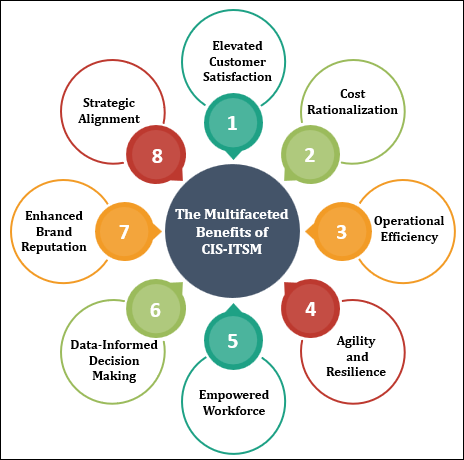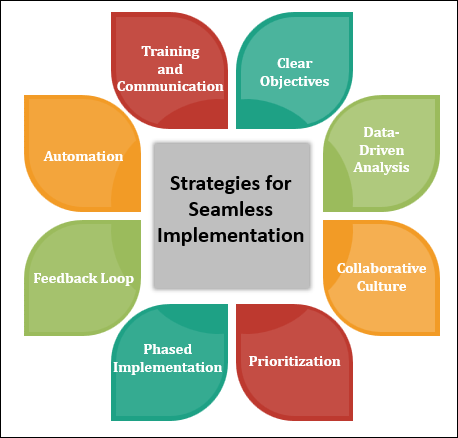CIS-ITSM
In a world defined by rapid technological advancement, the critical importance of seamless IT Service Management (ITSM) in attaining operational excellence cannot be overstated. In response, organizations are awakening to the transformative potential of Continuous Improvement in IT Service Management (CIS-ITSM) as a dynamic approach to orchestrating perpetual progress.

This blog embarks on an illuminating journey into the realm of CIS-ITSM, unraveling its intricacies and illuminating its manifold advantages. From unraveling its nuanced underpinnings to deciphering its strategic implementation, we aim to provide a comprehensive understanding of CIS-ITSM's transformative power. This exploration culminates in recognizing its profound impact, propelling IT service management towards unprecedented zeniths of efficiency and effectiveness.
Understanding the Essence of CIS-ITSM
Continuous Improvement in IT Service Management (CIS-ITSM) encapsulates a methodology focused on perpetual enhancement within IT service processes. Rooted in the principles of continuous improvement and often aligned with frameworks like ITIL, CIS-ITSM champions the idea of iterative progress. This approach involves consistently evaluating existing ITSM practices, pinpointing areas for refinement, and effecting incremental changes to achieve optimal service delivery and operational efficiency.
The essence of CIS-ITSM lies in its commitment to adaptability and resilience. By fostering a culture of ongoing learning and adjustment, organizations can proactively align IT services with ever-evolving customer demands and technological advancements. CIS-ITSM transcends static, traditional approaches by introducing a dynamic element that emphasizes agility and responsiveness. As organizations embrace the essence of CIS-ITSM, they position themselves to stay ahead in an ever-changing digital landscape, delivering superior IT services while remaining attuned to emerging opportunities and challenges.
The Multifaceted Benefits of CIS-ITSM
The concept of Continuous Improvement in IT Service Management (CIS-ITSM) offers a spectrum of multifaceted benefits that reverberate across an organization's operations. Delving into the core of CIS-ITSM reveals its profound impact on various aspects:
- Elevated Customer Satisfaction: CIS-ITSM places customers at the forefront. By consistently aligning IT services with customer feedback and evolving needs, organizations can attain higher levels of customer satisfaction. This translates into strengthened customer relationships, loyalty, and positive brand perception.
- Operational Efficiency: The iterative evaluation and optimization of IT processes central to CIS-ITSM lead to the identification and elimination of bottlenecks and inefficiencies. The result is heightened resource utilization, reduced waste, and ultimately, enhanced operational efficiency.
- Cost Rationalization: A central tenet of CIS-ITSM is the elimination of wasteful practices and processes. Through continuous assessment and refinement, organizations can uncover cost-saving opportunities, thereby improving financial sustainability.
- Agility and Resilience: The dynamic nature of CIS-ITSM empowers organizations to remain agile and responsive. Adapting to technological advancements, shifting business demands, and unforeseen challenges becomes second nature, fostering resilience in an ever-changing environment.
- Empowered Workforce: Involving employees in the CIS-ITSM journey harnesses their collective creativity and expertise. This engagement not only drives innovative solutions but also cultivates a sense of ownership, boosting overall morale and motivation.
- Data-Informed Decision Making: CIS-ITSM relies on data-driven insights to inform improvements. This methodical approach ensures that decisions are grounded in factual information, minimizing guesswork and leading to more informed strategic choices.
- Enhanced Brand Reputation: Organizations that consistently enhance their IT services through CIS-ITSM earn a reputation for excellence. This positive perception bolsters brand credibility and establishes the organization as a preferred partner in the industry.
- Strategic Alignment: CIS-ITSM necessitates regular assessment of IT processes against organizational objectives. This alignment ensures that IT services remain synchronized with broader business strategies, reinforcing organizational cohesion

Strategies for Seamless Implementation
Implementing Continuous Improvement in IT Service Management (CIS-ITSM) requires a well-structured approach to ensure a seamless integration of the methodology into an organization's processes. Here are strategies that can facilitate the implementation of CIS-ITSM:
- Clear Objectives: Define specific goals and objectives for CIS-ITSM implementation. Whether it's reducing incident response times, enhancing service quality, or increasing customer satisfaction, clarity in objectives is essential to guide the improvement efforts.
- Data-Driven Analysis: Gather and analyze relevant data about existing ITSM processes, performance metrics, and customer feedback. This data provides insights into areas that require improvement and serves as a baseline for measuring progress.
- Collaborative Culture: Foster a culture of collaboration among teams and departments. Encourage regular brainstorming sessions and open discussions to gather diverse perspectives and ideas for improvement.
- Prioritization: Not all aspects of ITSM need immediate attention. Prioritize improvements based on their potential impact and feasibility. This ensures that resources are allocated effectively and improvements are rolled out strategically.
- Phased Implementation: Implement changes gradually to minimize disruption. Break down improvements into manageable phases, testing and refining each before moving to the next. This approach mitigates risks and allows for continuous monitoring.
- Feedback Loop: Establish mechanisms to gather feedback from stakeholders, including customers and employees, after implementing changes. This feedback provides insights into the effectiveness of the improvements and informs future iterations.
- Automation: Leverage automation tools to streamline repetitive and manual tasks. Automation not only improves efficiency but also reduces the chances of errors.
- Training and Communication: Provide training and communication to employees about the changes being introduced. Ensuring that all stakeholders understand the rationale and benefits of CIS-ITSM enhances its adoption and success.
The Strategic Importance of CIS-ITSM in Operational Excellence
Operational excellence, the zenith of organizational efficiency, is achieved through a relentless commitment to refining practices. CIS-ITSM stands as a cornerstone in this pursuit, offering a paradigm shift from reactive to proactive ITSM practices. By continuously enhancing processes, organizations remain adaptable to technological evolutions, regulatory shifts, and ever-evolving customer expectations.
Furthermore, embracing operational excellence through CIS-ITSM positions organizations as industry pacesetters. A consistent dedication to delivering superior services enhances brand reputation, fosters customer trust, and contributes to long-term success.
Conclusion
As the digital landscape evolves, the significance of proficient IT service management stands prominently. CIS-ITSM shines as a guiding light toward operational excellence, presenting a systematic route to perpetual advancement. By wholeheartedly embracing the ethos of CIS-ITSM and fostering an environment of continual fine-tuning, organizations position themselves at the forefront of the ever-changing landscape.
This commitment ensures they remain agile, capable of adapting and primed for sustained accomplishments in the face of evolving challenges and opportunities. In an era of constant progress, CIS-ITSM serves as a compass, steering organizations towards the pinnacle of IT service management and fostering a legacy of triumph in the digital age.








